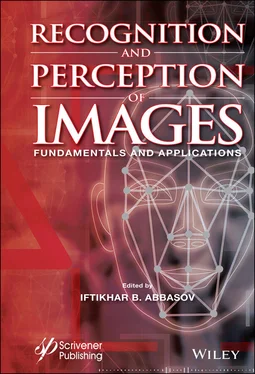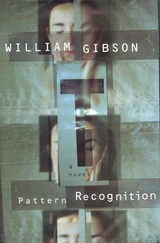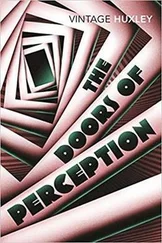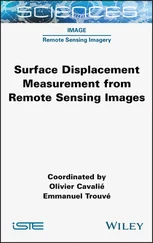1 ...8 9 10 12 13 14 ...19 
Figure 1.2.15 Brightness assimilation [Ghosh, Bhaumik, 2010].
Illumination of one receptor reduces the sensitivity of its neighboring receptors, and lateral inhibition occurs. When simultaneously illuminated, each receptor responds less actively than in the case of individual stimulation. Similarly, the ganglion cells of the human retina function in a human; they have complex interrelationships and are not individually excited. Neural connections using lateral braking affect the activity of each other, thereby ensuring a clear perception of edges and boundaries.
1.2.6 Mach Bands, Hermann’s Grid
To demonstrate the effect of lateral inhibition, consider the stepwise stretching of gray color in Figure 1.2.16. The left side of each vertical rectangular strip will appear a little lighter than its right side, which causes an increase in edge contrast. However, each strip has the same lightness; it is filled with a uniform gray color. This can be easily seen if we examine each rectangle alternately, covering the others. The effect of changing the lightness of the marginal sections is named after the 19th-century German physiologist Ernst Mach, who first described this phenomenon [Abbasov, 2016].
Spatial frequencies
Contrast areas of the surrounding field of view can be characterized by spatial frequency, i.e., the number of luminosity variations in a certain part of space. For experimental confirmation, consider Figure 1.2.17. The left upper lattice has a relatively low spatial frequency (wide bands), and the lower one has a higher frequency (narrow bands). The spatial frequencies (bandwidths) of the grids in Figure 1.2.17, on the right are identical and they occupy an intermediate position. Cover the grids in Figure 1.2.17, on the right and for at least 60 s, carefully examine the grids in Figure 1.2.17, on the right, fixing the view on the central horizontal strip between the gratings. After completion of the adaptation period, translate the view into the strip in the center between the two gratings in Figure 1.2.17, on the right. Spatial frequencies will no longer seem identical: the spatial frequency of the upper lattice will seem higher (denser) than the spatial frequency of the lower lattice [Shiffman, 2008], [Gusev, 2007].
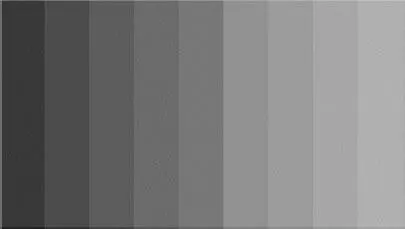
Figure 1.2.16 Mach bands.
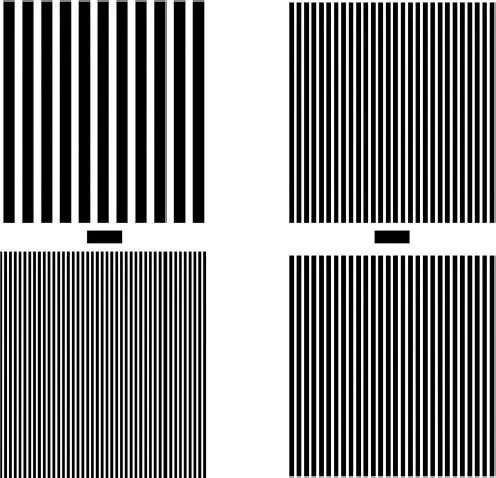
Figure 1.2.17 Spatial frequency.
Consider the effects based on the phenomenon of lateral inhibition, these include the lattice of Hermann and light contrast. Figure 1.2.18shows the German grid (German physiologist Ludimar Hermann in 1870), it consists of a white square grid pattern on a black background. The lightness of the white stripes is the same along the entire length; however, phantom gray spots will appear at their intersections. They are due to the suppression of the neural activity of neighboring cells of the retina. If we concentrate our gaze on a separate point of intersection, the gray spot will disappear. In this case, the image is projected on the central fossa, and gray spots appear on other crosshairs, which will be projected on the peripheral areas of the retina with high sensitivity.
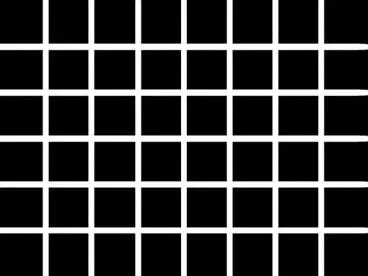
Figure 1.2.18 Hermann’s grid.

Figure 1.2.19 “Complementary” grid of Hermann.
You can observe the colored spots on the crosshairs; for this you can choose a grid and a background complementary in color. Such a color grid is shown in Figure 1.2.19, blue spots will appear on the yellow cross hairs [Abbasov, 2019]. When scaling Hermann’s grid, the “phantom” spots will be more stable; for this it is necessary to move the pattern away to the projection of the grid on the retina. From a long distance, the stripes will narrow and phantom spots will be visible regardless of the gaze fixation.
A further example of the spatial interaction of neighboring areas of the retina is light contrast. It lies in the fact that the lightness of a small closed figure depends on the intensity of lightness of the massive background area ( Figure 1.2.20) [Abbasov, 2016]. From the point of view of light reflected by them, all four central gray circles are identical; however, it seems that they differ in lightness. A circle on a dark background (left edge) seems lighter than a physically identical circle on a light background (right edge). Therefore, this means that the perceived lightness of the surface depends on the intensity of its background.
1.2.8 Object Identification
There are several theories of identification based on the distinctive features of surrounding objects. At the initial stage of anticipation, there is a fast processing of the information received, which allows you to perceive the basic, very simple and noticeable distinctive features of the object, the so-called perceptual primitives. The surfaces differ from each other by the simplest elements of the texture - by the textones, the specific distinguishable characteristics of the elements forming the texture. In Figure 1.2.21, one can observe a textural background from the set of letters P, Б, Ь; however, to find the letter B on such a background, concentration of attention will be required.

Figure 1.2.20 Light contrast.

Figure 1.2.21 Texture pattern of various letters.
According to another theory, object recognition begins with processing information about a set of primitive distinguishing features. Any object of three-dimensional space can be decomposed into a number of geometric primitives (geons: sphere, cube, cylinder, cone, pyramid, torus, etc.). On the basis of various operations of combining, intersection of surfaces of primitives, you can create new or analyze existing objects. Similarly, any letter can be obtained from a set of lines and curves. According to the theory of geons (geometric ions) by Biederman [Shiffman, 2008], a set of 36 geons will be enough to describe the shape of all the objects that a person is able to recognize. According to the experiments, the object is recognized; its geons are perceived as well. Usually, the description of an object includes not only its features, but also the relationships between the constituent parts. After describing the shape of the object, it is compared with an array of geons that are stored in memory, and the most appropriate match is found.
Читать дальше
